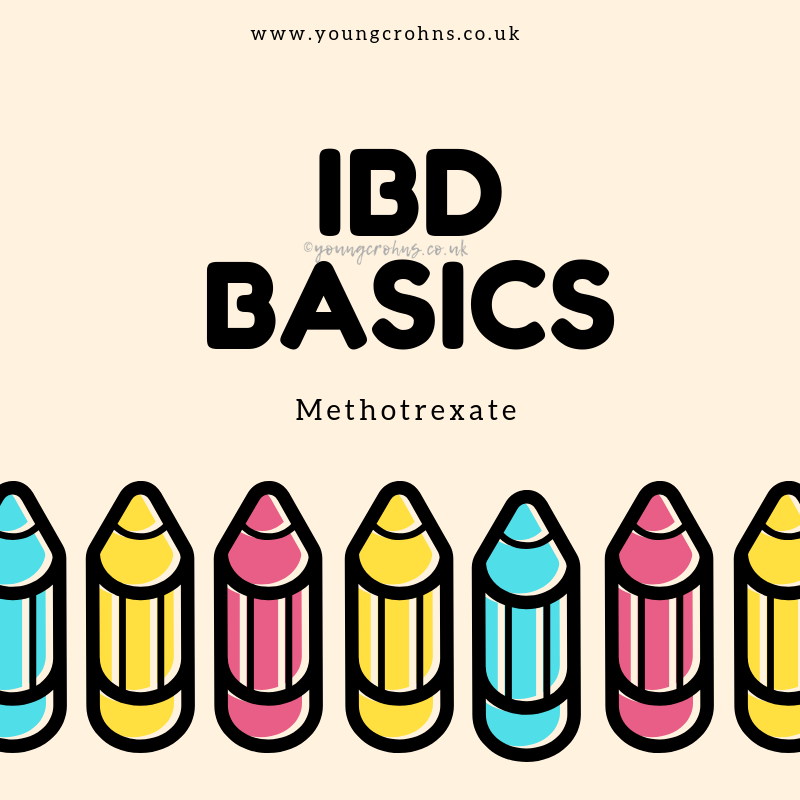
IBD Basics: Methotrexate
Disclaimer: This information is based on my own research into this particular aspect of IBD as well as some personal experience and should not be used as medical advice or a diagnostic tool. The suggestions given within are taken from sources laid out in the references header. If you seek advice regarding the things you experience within your own disease, please contact your IBD team for medical advice.
If you are looking for the entire ‘IBD Basics’ series, you can find them all here.
What is Methotrexate & Why is it important?
Methotrexate is part of a group of medication called immunosuppressants. They work to help reduces inflammation in the body by dampening down the activity of the immune system. It works particular well at controlling the inflammation in the gut, helpful for IBD. As IBD is an autoimmune response to too much active inflammation in the bowel, Methotrexate works well in many cases, but it comes with side effects.
Methotrexate interferes with the growth of certain cells of the body, especially cells that reproduce quickly, such as cancer cells, bone marrow cells, and skin cells. It is used to treat certain types of cancer of the breast, skin, head and neck, or lung. It is also used to treat severe psoriasis and rheumatoid arthritis. Methotrexate is usually given after other medications have been tried without successful treatment of symptoms.
Why is it used to treat IBD?
Methotrexate can be prescribed to induce or maintain remission for Crohn’s Disease if you keep having relapses while on standard treatments for IBD, such as Aminosalicylates (5-ASAs) and steroids, or if you have had an adverse reaction to either Azathioprine or Mercaptopurine. It also decreases the long-term need for steroids and for that reason, it is sometimes referred to as a “steroid-sparing” drug. Although currently unlicensed for use in IBD, it has been widely used to treat people with Crohn’s, and rather less commonly people with Ulcerative Colitis. Methotrexate may also be given as combination therapy with biological medicines such as Infliximab or Adalimumab (Humira).
How is it used to treat IBD?
Methotrexate does not work immediately. It can take up to 3 months before your symptoms improve. Although you may not feel the benefit for some time, it does not mean that the methotrexate is not working.
Methotrexate is taken as a single ONCE A WEEK dose on the same day each week. It can be taken in two different ways – either by tablets or by injection. Sometimes people start off on the injection form, before moving to oral tablets.
- Tablets: Taken by mouth, after food. The tablets should be swallowed whole with a glass of water while sitting upright or standing. Do not crush or chew them.
- Injection: Methotrexate injections can be either subcutaneous (under the skin) or intra-muscular (into muscle). These can be given at the clinic by the nurse, or alternatively your nurse may train you to inject the methotrexate yourself.
Doctors and hospitals have different ways of prescribing methotrexate. Some doctors may recommend starting with weekly injections for 8-12 weeks to induce remission, and then move to weekly oral tablets if it is working well, while other doctors may recommend just the tablet form or the injection form.
Some specialists start at a low dose of methotrexate and slowly increase it to a maximum of 25mg a week, while other doctors may start at 25mg a week and slowly reduce it.
The methotrexate tablets come in two different strengths: 2.5mg and 10mg. The two strengths are different shapes, but the colour is very similar. It is important that you take the correct strength and dose of tablets. If you think you have the wrong strength, do not use your medicine before checking with your doctor, pharmacist or nurse. Some hospitals and doctors have agreed to use only the 2.5mg tablets to prevent any confusion. Your doctor, pharmacist or nurse will be able to tell you if this applies in your area.
While on methotrexate, you will also be prescribed folic acid tablets. Folic acid is a vitamin that can help your body cope with methotrexate and help reduce some of the possible side effects. Do not take the folic acid on the same day as your weekly methotrexate dose, as this may prevent you getting the full benefit from your treatment.
Methotrexate and folic acid tablets can look similar and it is very important to distinguish between the two. Always keep them in their individual original containers.
Side Effects & Important Information
- You will need several tests to make sure it is safe for you to start the medication. These include blood tests to check your liver, kidney and blood function, as well as tests for infections such as hepatitis B and C, HIV and varicella (chicken-pox), along with a chest x-ray.
- For women it is important to make sure you are not pregnant before starting treatment. If you are unsure, you will be required to take a pregnancy test.
- You will need to have regular blood and liver tests while you are on Methotrexate to check that the treatment is not affecting your blood or liver. This may be to have blood tests every 1-2 weeks for the first 2 or 3 months until therapy is stabilised, and then every 1-3 months thereafter. This can show if you are developing side effects. This treatment monitoring may be managed by your hospital team or shared between the hospital and your GP.
- Always check the dose of your methotrexate and the strength of the tablets supplied. Both the Methotrexate and folic acid tablets look very similar, as well as the doses of Methroextate look similar in the tablet forms. Please check these as soon as you have your medication.
- Try to avoid close contact with people with infections. Methotrexate affects the way the body’s immune system works, which can make you more prone to infections. Even a mild infection, such as a cold or sore throat, could develop into a serious illness.
- You may also be at greater risk of becoming more seriously ill from the viruses which cause chickenpox and shingles, measles and pneumococcus disease. If you are not already immune you may be able to be vaccinated before starting treatment.
- Women who are trying to conceive or during pregnancy should not take methotrexate because it can cause birth defects or miscarriages. The evidence of risk to the foetus when the man is taking methotrexate is less clear, but the drug may affect the formation of sperm, so men as well as women are advised not to conceive while on methotrexate.Therefore, doctors advise both men and women to use reliable contraception during treatment. Also, because traces of methotrexate can remain in body tissue for some time, couples are advised to avoid pregnancy for at least 3-6 months after stopping these drugs.
- Methotrexate can increase the skin’s sensitivity to sunlight, and the risk of developing some types of skin cancer. This can be reduced by wearing hats, light clothing and high SPF sun block.
Everyone responds differently to the medications but possible side effects include:
- nausea, especially at the start of treatment
- flu-like symptoms: headache, vomiting, diarrhoea & fatigue
- mouth ulcers
These common side effects can be managed easily by taking the folic acid supplement as prescribed and taking your methotrexate at a different time of day, for example before you go to bed at night.
More serious side effects are listed below (they affect between one in 1,000 and one in 10,000 patients). These will require more rigorous monitoring, or in some situations, to stop the medication.
- Allergic reactions can be caused by any medications: signs may include an itchy skin rash, swelling of the face, lips, mouth, or wheeziness. If any of these symptoms occur you should contact your doctor immediately.
- Supression of your bone marrow resulting in a reduction in the number of red cells, white cells (that fight infection) and platelets (that assist in clotting): this will be monitored by blood tests. Please report any signs of recurrent sore throat, fever, infections, signs of increased unexplained bruising or bleeding, or mouth ulcers.
- Abnormal liver function test: these will be monitored by blood tests but if you notice jaundice (yellowing of the eyes or skin), severe itching of the skin or long term dark urine, contact your IBD team.
- Abnormal kidney function: this will be monitored with your regular blood tests.
- In rare cases, methotrexate can affect the lungs. Tell your doctor if you become breathless, have a persistent cough, chest pain or difficulty breathing.
Some other side effects of methotrexate are listed below. Seek medical attention if you develop any of these side effects, or notice any other unusual symptoms while on methotrexate:
- Skin rash
- Swollen glands
- Mouth or gum ulcers
- Hair loss
- Acne
- Abdominal pain
- Vaginal ulceration
- Headache or dizziness or unusual sensations in the head and confusion
- Fatigue or drowsiness
- Blurred vision
- Mobility problems
Here are some important things to think about:
- Usually the benefits of the medicine are more important than any minor side effects.
- Side effects may go away after you take the medicine for a while.
- If side effects still bother you and you wonder if you should keep taking the medicine, call your doctor. He or she may be able to lower your dose or change your medicine. Do not suddenly quit taking your medicine unless your doctor tells you to.
Your doctor should always talk through the risks and benefits before you start Methotrexate. Let your doctor or IBD nurse know about any new symptoms you develop, whenever they occur.
My Experience
I began taking Methotrexate about a year or so into my treatment of Infliximab. It was early 2015 and my IBD nurse decided it was time to test my blood for Infliximab antibodies and just see what was being retained and how effective a treatment this was – I was complaining of extreme fatigue, abdominal pain and more and more frequent diarrhea. When the results came back, we discovered by body was not retaining very much of the Infliximab and we needed a fresh approach. I opted to try Methotrexate alongside my Infliximab infusions to help bolster my treatment and get me well again.
So we decided to try the first of two things – adding in Methotrexate to my regime – before decreasing the time between infusions. The risks of Methotrexate were explained to me – I was under no elusion that this drug would work wondered, it wouldn’t be effective right away too, so this was just an attempt to get me through the rest of 2015 without an admission for a flare up. Knowing that MXT would take a while to work, we started this secondary treatment plan straight away. I started on a low dose and then it got increased as my blood work came back after a month. So we began in the March and slowly but surely I got used to my weekly regiment for taking Methotrexate: thrice folic acid, followed by a weekly dose of Methotrexate. We did this for the eight weeks leading up to my next infusion of Infliximab and tested my blood to gain some baselines.
I stayed on this combo for the next four infusions; so about 6 months. In those six months, we increased the Methotrexate to 25mg and waiting to see more improvement. But my the end of July, something changed and we didn’t know why my body still wasn’t having much response to the Inflximab. And unfortunately, by the September I’d lost all response to Infliximab and needed to change my biological treatment plan. We also at that point, started discussing surgical options and a second medical opinion from another hospital.
Whilst on MXT I did suffer from colds and coughs – during the Spring and into the Summer – but nothing else really happened, I got minimal side effects. I felt this was a good option for me. However, since then, I’ve had an ongoing battle with my LFTs whilst in remission. No-one like to point fingers at it being the MXT but I think it could be. We have discussed restarting MXT if I lose response to Vedolizumab this year, but its been put on the back burner for a little while.
Whilst I know I felt okay on this combination and whilst I also know what lay ahead for me now, with hindsight; I would still take Methotrexate again. I understood the risks and the benefits of this medications, in conjunction with my mono-biologic treatment plan. It was a last-ditch attempt to get me through the months until Vedolizuamb was available on the NHS.
Even though it wasn’t an appropriate or successful treatment option for me, I did blog about it:
March Madness & MXT – March 19th, 2015
Infliximab #11 : Ongoing Troubles – May 19th, 2015
Infliximab #12 : The Worries on a Troublesome Colon Pt 1 – July 2nd, 2015
Oh. Oh Dear – July 28th, 2015
I ran a Twitter poll for this post, results can be found here.
Have you had to take Methotrexate for your IBD? Have you found it useful as a treatment option? Have you any bad experiences, side effects or reactions? If so, what happens/ed next?
Do you have any questions or queries? Or just want to share your own experiences? Leave me a reply or tweet me @sapphire20 or find my blog page on Facebook!

Sources:
BMJ Journal GUT – Methotrexate in Crohn’s disease (pdf)
BMJ Journal GUT – Methotrexate: a useful alternative in Crohn’s disease? (pdf)
Crohn’s and Colitis UK – Methotrexate (pdf)
Guys & St Thomas’ NHS Foundation Trust – Methotrexate for Inflammatory Bowel Disease: What you need to know
Crohn’s Colitis Foundation – Methotrexate
Crohn’s Colitis Foundation – Maintenance Therapy
European Crohn’s And Colitis Organisation – Methotrexate



